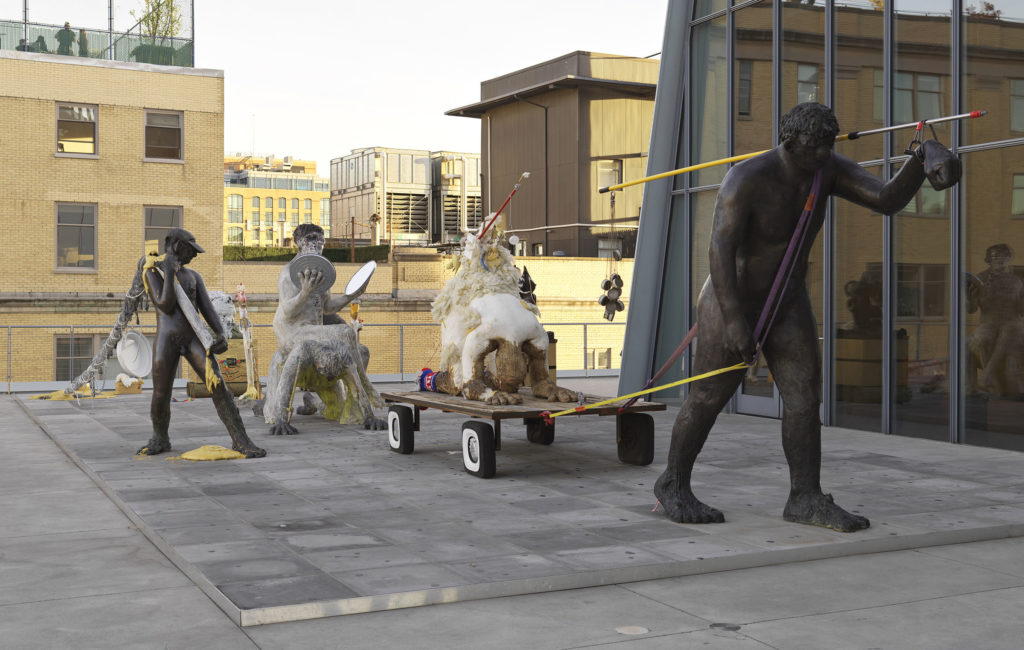[ad_1]
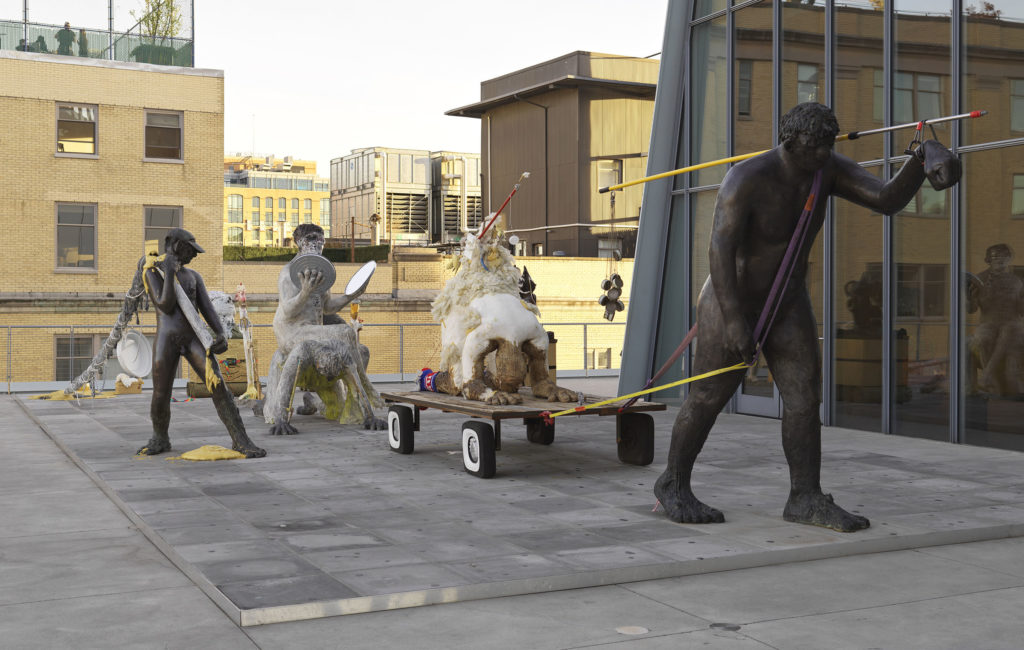
Nicole Eisenman, Procession, mixed media, 2019.
OBJECT STUDIES/COURTESY THE ARTIST, VIELMETTER LOS ANGELES, AND ANTON KERN GALLERY, NEW YORK
Nicole Eisenman’s Procession was, hands down, the standout entry of the 2019 Whitney Biennial. The multi-figure sculpture is, by turns, baffling, bold, hopeful, lumbering, imaginative, irreverent. Almost every reviewer of the exhibition mentioned the unusual caravan of fellow travelers. Remaining on view until the end of October, Eisenman’s outdoor, site-specific work, which weathered the elements during the course of the show surprisingly well, is comprised of 11 disparate figures and heads executed in a variety of materials, ranging from bronze, plaster, and urethane foam to acrylic yarn, gold leaf, and butcher’s wax. There are also a few odd objects such as a flagpole, a fly swatter, a fog machine, some empty tuna fish cans, and the lid of a coffee cup. All told, its wall label itemizes more than 75 components used by the 54-year-old artist, who’s made her name as a trailblazing painter.
Eisenman has become a two-sport threat, a phrase associated with the unusual athletes who excel in, say, both baseball and football, like Deion Sanders. In the entertainment world, singer/songwriters are fairly common, but painter/sculptors are very rare entities.
Years ago, aiming to name the outstanding sculptors of the 20th-century, some commentators regularly cited versatile European artists who were dual practitioners. Things changed during the 1960s when the pioneering Minimalists rejected painting to instead execute freestanding art that Donald Judd termed “specific objects.” The concept of the painter/sculptor fell by the wayside. And the making of convincing statues was upended long before that.
But right now that is exactly what Nicole Eisenman is doing. She has been sculpting slightly larger than life-size figures that, among other activities, have lolled on the ground, sat on a precarious perch, and trudged onward. Moreover, she has consistently introduced her full-bodied forms as multi-figure compositions—a form whose appearance throughout the history of art has often been a striking occurrence.
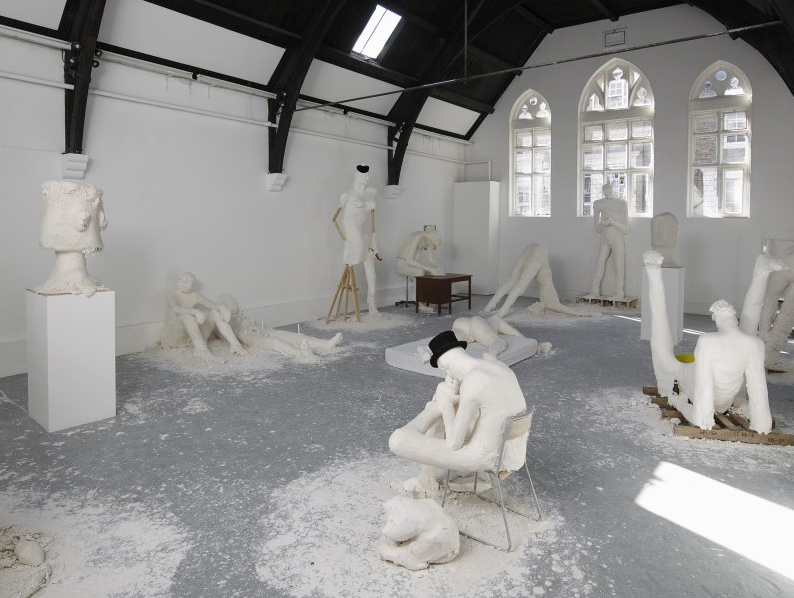
Installation view of Nicole Eisenman’s Tis but a scratch’ ‘A scratch?! Your arm’s off!’ ‘No, it isn’t”, 2013, at Studio Voltaire, London.
ANDY KEATE/COURTESY THE ARTIST, GALERIE BARBARA WEISS, BERLIN, LEO KOENIG INC., NEW YORK AND SUSANNE VIELMETTER, LOS ANGELES
Seven years ago, Studio Voltaire in London invited Eisenman to participate in a month-long residency that would culminate in a solo show. The program could not have been more radical. She was asked to create something she ordinarily never would. Consequently, instead of making paintings or large drawings, the artist requested 1,000 pounds of plaster and lots of plywood 2-by-4s. Every two days, she completed a life-size figure, ending up with 15 or 16, and what she remembers as “a giant plaster mess.” After the exhibition, the fledgling sculptor saved only three of them.
A few months later, for the 2013 Carnegie International in Pittsburgh, Eisenman installed in the Carnegie Museum’s sculpture hall, which usually features Greek statues, the trio of figures that survived the London massacre, as well as four new plasters. Despite being rather generalized—with featureless faces and lithe bodies—they were gendered. One sculpture, which lay on the ground, wore a crown of mugwort; another sat on the second-floor balustrade, its legs dangling above the open space below. These figures reflect the artist’s growing confidence working with plaster; and are less tentative than her fledgling efforts in London. At this point, she also began thinking about casting her figures in bronze. In a video the museum prepared, Eisenman said, “There’s more wrong with them than what’s right with them.” A jury of curators who had organized previous internationals did not see it that way. They awarded her the prestigious Carnegie Prize, an honor previously given to figures like Henri Matisse (1927) and Pablo Picasso (1930).
When Kasper König began organizing Skulptur Projekte Munster for 2017, he remembered Eisenman’s figures from Studio Voltaire and the Carnegie. Though she was still active as a painter, he asked her to participate in his sprawling, every-10-years citywide group show in that German university town. This would be the first time Eisenman would be exhibiting work outdoors, and she rose to the occasion.
With an extended window for prepping work, Eisenman enjoyed what she described to me as “a long and thoughtful process.” For a month, she sought a place in Münster that would offer an interesting context for her as-yet-unrealized figures. A lawn in a clearing that Martin Kippenberger had once used fit the bill. With a shallow pool and sculptures surrounding around it, Eisenman wanted her figures to appear as if they had walked out of the woods and just plopped themselves down. This scenario would explain the casualness of their gestures.
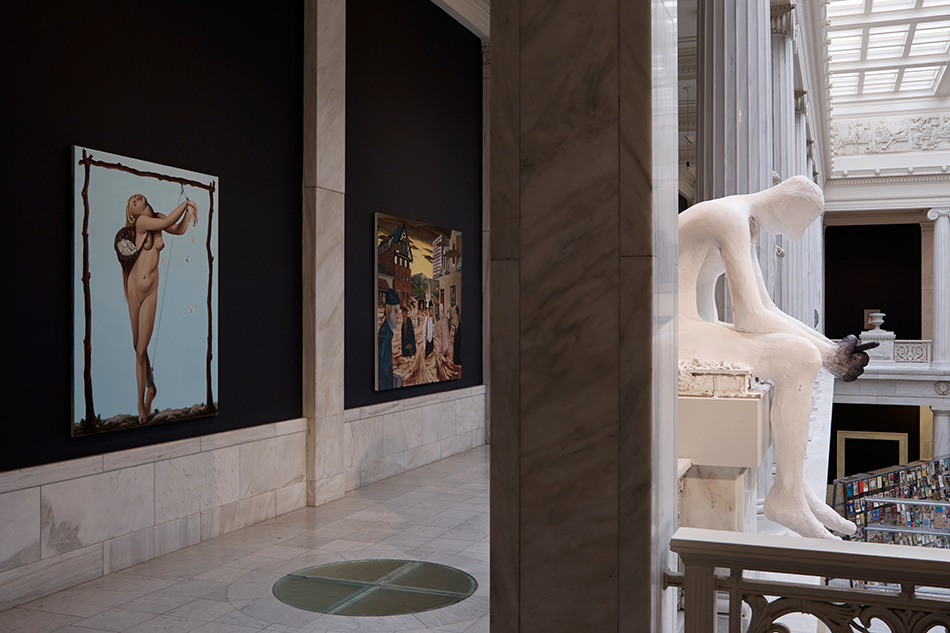
Installation view of Nicole Eisenman’s Spring Fling, Coping, and Prince of Swords at the 2013 Carnegie International in Pittsburgh.
GREENHOUSE MEDIA/COURTESY THE ARTIST AND KOENIG AND CLINTON, NEW YORK
Sketch for a Fountain, the ensemble’s title, was composed with two works cast in bronze and three that remained in plaster. The group looked as if they were all enjoying a hot summer’s day. Although the bodies of the figures grew more substantial, they still seem gender fluid. One of the bronze compatriots stood in the pool, water spouting out of its leg, while the other held a liter of beer. Eisenman was pleased that kids played in her fountain in disguise. As it was, she’d partly chosen the site because it was in a residential neighborhood and near a school.
Subtly, Eisenman, who knows her art history well, was updating several classics of 20th-century sculpture. She called to mind Aristide Maillol’s River (1943), a beloved fixture of the Museum of Modern Art’s sculpture garden. Instead of a recumbent, bare-breasted nude woman with flowing tresses, she created several queer bodies. Glimpsed from the rear, the standing figure has a passing resemblance to Gaston Lachaise’s Standing Woman of 1932. As for the can of liquid refreshment held by one figure, doesn’t that evoke Jasper Johns’s Ballantine Ale cans of 1960?
Now that three of her Münster figures have been cast in bronze and placed around a shallow pool in the Back Bay section of Boston, Eisenman again hopes her work will be a place for people to come and relax. She’s had benches constructed so that nannies and students, among others, can sit. And, at the Nasher Sculpture Center in Dallas, which has recently acquired another version of Sketch for a Fountain (this one with five bronzes), the artist doesn’t expect museum visitors to wade into the water. Rather, the work takes its place in the context of important sculptures by other artists. Talk about a dramatic shift in priorities: bronzes by Rodin and de Kooning are nearby, as are metal constructions by Calder and Serra. With three variations on one theme, Eisenman’s practice has become astonishingly flexible. It has a root structure that allows for adaptations to be made.
Procession could not have been more timely. After all, protest marches are once again prevalent. At the Whitney, visitors are encouraged to step onto the cement-squared platform and mingle with the figures who all face forward. If Rodin took his Burghers of Calais (1884–89) off the pedestal, Eisenman has engendered a situation existing in the gap between art and life. Additionally, she took care to have her installation function as a site-specific work. Offered the fifth-floor terrace by the biennial’s co-curators, the artist held out for the sixth-floor location so that her work would be seen against the skyline of Manhattan.
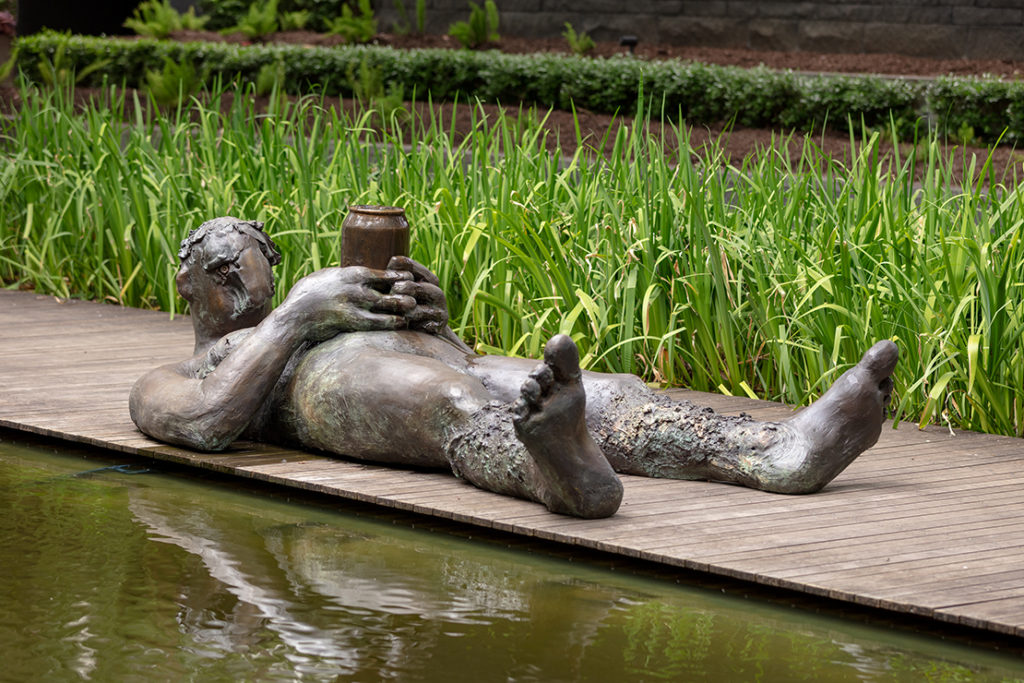
Nicole Eisenman, Sketch for a Fountain (detail), 2017 (cast 2018-19), bronze.
KEVIN TODORA
Then there’s the matter of the number of elements she included. Some parts are permanent; others, semi-permanent; and a few were added specifically for this show. To fill out the space, she included a trio of alien-like “walkers.” These runt-like creatures are striding stick figures with gangly arms and bizarre, butter-creamish heads toward the back of her group, and they are accompanied by three unusual heads on shipping crates, which she has exhibited elsewhere. (Her heads have also been much admired at the current Venice Biennale.) As an ensemble, the hybrid characters remind me of the bar scene in the first Star Wars movie, which opened in 1977. Eisenman, born in 1965, grew up with the series as a touchstone. (Huma Bhabha and Thomas Houseago, two of her contemporaries, seem to have been more inspired by The Terminator, which opened in 1984.)
As for the materials used to make Procession, Eisenman was like the proverbial kid in a candy store—or a sculptor let loose in a hardware store or an art supply shop. Availing herself of a multitude of substances allowed the artist to sculpt images that are distinct, particular, and otherworldly. The myriad details reward prolonged looking. When, for example, was the last time you found a wad of gum stuck between the foot of a bronze figure and the ground beneath it?
The insides of metal trash-can covers were transformed into mirrors that serve as sun reflectors for a seated behemoth. On the front of a cart bearing a kneeling figure, a small cast of an animal’s head functions as if it were a hood ornament identifying the make of an automobile. There’s even an injection of scatological humor, a fog machine that makes it seem as if that bent-over form is passing gas every so often. Wherever you look, something begs to be noticed: square wheels with inscriptions attached to the cart; blobs on the ground that resemble early works by Lynda Benglis. And Eisenman includes commonplace items that identify her figures. That massive individual on his knees wears New York Giants socks that underscore his nature as a sufferer; and a guy with Bumblebee tuna cans on a pole that rises and drops suggests he’s a kind of fisherman.
With Procession and Sketch for a Fountain, Eisenman has, within a few short years, built an idea that can hold a lot of things.
[ad_2]
Source link

